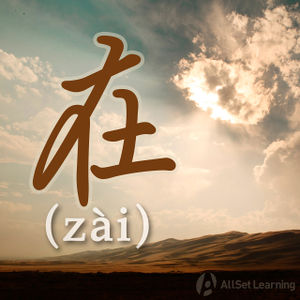Difference between revisions of "Expressing actions in progress with "zai""
m (WikiSysop moved page Expressing actions in progress to Expressing actions in progress with "zai") |
|||
| (6 intermediate revisions by 3 users not shown) | |||
| Line 1: | Line 1: | ||
{{Grammar Box}} | {{Grammar Box}} | ||
| − | |||
在 (zài) and 正在 (zhèngzài) can be used as [[auxiliary verb|auxiliary verbs]] to express that an action is ''ongoing'' or ''in progress''. This is often the equivalent of ''present continuous'' in English, which is how we express that an activity is happening ''now''. | 在 (zài) and 正在 (zhèngzài) can be used as [[auxiliary verb|auxiliary verbs]] to express that an action is ''ongoing'' or ''in progress''. This is often the equivalent of ''present continuous'' in English, which is how we express that an activity is happening ''now''. | ||
| Line 38: | Line 37: | ||
</div> | </div> | ||
| − | There is no need to worry too much about when to use 在 (zài) or 正在 (zhèngzài), since they basically mean the same thing. 正在 (zhèngzài) usually shows that the action is in progress. "在 (zài) + Verb" is more commonly used than "正在 (zhèngzài) + Verb," but both are | + | There is no need to worry too much about when to use 在 (zài) or 正在 (zhèngzài), since they basically mean the same thing. 正在 (zhèngzài) usually shows that the action is in progress (''right now''). "在 (zài) + Verb" is more commonly used than "正在 (zhèngzài) + Verb," but both are fine to use. |
== See Also == | == See Also == | ||
| Line 49: | Line 48: | ||
=== Books === | === Books === | ||
| − | + | {{Source|HSK Standard Course 1|100}} | |
| − | + | {{Source|Basic Patterns of Chinese Grammar|41-2}} | |
| − | + | {{Source|Chinese: An Essential Grammar, Second Edition|60-1}} | |
| − | + | {{Source|Integrated Chinese: Level 1, Part 1 (3rd ed)|209-10}} | |
| + | {{Source|New Practical Chinese Reader 2 (新实用汉语课本2)|218-9}} | ||
[[Category:A2 grammar points]] | [[Category:A2 grammar points]] | ||
| + | {{HSK|HSK1}}{{2021-HSK|HSK1}} | ||
{{Used for|Referring to the present }} | {{Used for|Referring to the present }} | ||
{{Used for|Indicating conditions}} | {{Used for|Indicating conditions}} | ||
{{Used for|Describing actions}} | {{Used for|Describing actions}} | ||
| − | {{Basic Grammar|在|A2|(正)在 + Verb|我们 <em>正在</em> 吃饭。|grammar point|ASG846EA}} | + | {{Basic Grammar|在|A2|(正) 在 + Verb|我们 <em>正在</em> 吃饭。|grammar point|ASG846EA}} |
{{Rel char|正在}} | {{Rel char|正在}} | ||
{{Rel char|正}} | {{Rel char|正}} | ||
Latest revision as of 09:23, 20 April 2021
-
Level
-
Similar to
-
Used for
-
Keywords
在 (zài) and 正在 (zhèngzài) can be used as auxiliary verbs to express that an action is ongoing or in progress. This is often the equivalent of present continuous in English, which is how we express that an activity is happening now.
You can use 正在 (zhèngzài) instead of just 在 (zài) to put a little more emphasis on an action that is in progress right now.
Structure
Subj. + 在 + Verb + Obj.
or
Subj. + 正在 + Verb + Obj.
Examples
- 她 在 看 书。She is reading.
- 妈妈 在 打 电话。Mom is making a phone call.
- 谁 在 里面 洗澡?Who is taking a shower in there?
- 阿姨 正在 打扫 我们 的 房间。The cleaning lady is cleaning our room right now.
- 昨天 晚上 七点,我们 在 吃饭。 Yesterday at 7pm, we were eating dinner.
- 老板 在 开会,没有 时间 见 你。The boss is currently in a meeting. He doesn't have time to see you.
- 我 现在 在 上班,不方便 离开。I am working now. It's not convenient for me to leave.
- 我们 正在 上课,请 你 等 一会儿。We are in class right now; please wait a moment.
- 你 正在 开车,不 可以 玩 手机。You're driving right now; you can't play with your cell phone.
- 你 给 我 打 电话 的时候,我 正在 跟 朋友 打 游戏 。When you called me, I was playing video games with friends.
There is no need to worry too much about when to use 在 (zài) or 正在 (zhèngzài), since they basically mean the same thing. 正在 (zhèngzài) usually shows that the action is in progress (right now). "在 (zài) + Verb" is more commonly used than "正在 (zhèngzài) + Verb," but both are fine to use.
See Also
- Aspect particle "zhe"
- Expressing actions in progress (full form) (more advanced usage)
Sources and further reading
Books
- HSK Standard Course 1 (pp. 100) Anything Goes (无所不谈) →buy
- Basic Patterns of Chinese Grammar (pp. 41-2) Anything Goes (无所不谈) →buy
- Chinese: An Essential Grammar, Second Edition (pp. 60-1) Anything Goes (无所不谈) →buy
- Integrated Chinese: Level 1, Part 1 (3rd ed) (pp. 209-10) Anything Goes (无所不谈) →buy
- New Practical Chinese Reader 2 (新实用汉语课本2) (pp. 218-9) Anything Goes (无所不谈) →buy



